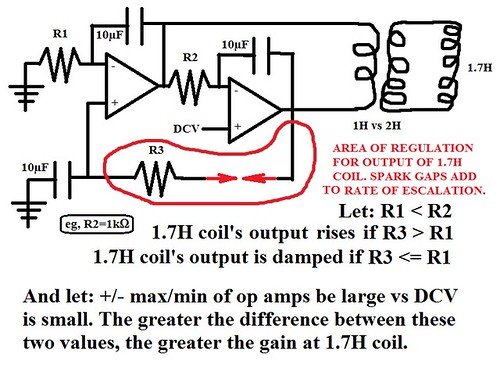High voltage operational amplifier is nothing new. Negative resistance is nothing new. While toying with a simulation of a 'sine wave generator' plus a load attached to it, I discovered that I can regulate the output up or down - overunity vs damping - by adjusting one resistor. And by adding one or more spark gaps of extremely low breakdown of resistance to voltage, I can maintain the smooth sine wave output at the load, accelerate the rise towards infinity, and reduce the voltage to amperage ratio so that the high voltage doesn't dominate the amperage too much -- at least while the spark gaps are engaged. I can only engage them momentarily since the escalation is too drastic to maintain for very long.
I use Paul Falstad's simulator. Despite all of the criticisms for simulating anything instead of doing it, or using his simulator in particular, I find it instructive to learn basic principles without much fuss, expense or risk of electrocution since I have no formal training with any of this.
The attached file should work at either of these three locations which host Paul's simulator...
Circuit Simulator Applet - originating author written in Java
Circuit Simulator - contributed portage to JavaScript
Circuit Simulator Applet with my mods [circuit loads immediately]
I use Paul Falstad's simulator. Despite all of the criticisms for simulating anything instead of doing it, or using his simulator in particular, I find it instructive to learn basic principles without much fuss, expense or risk of electrocution since I have no formal training with any of this.
The attached file should work at either of these three locations which host Paul's simulator...
Circuit Simulator Applet - originating author written in Java
Circuit Simulator - contributed portage to JavaScript
Circuit Simulator Applet with my mods [circuit loads immediately]



Comment